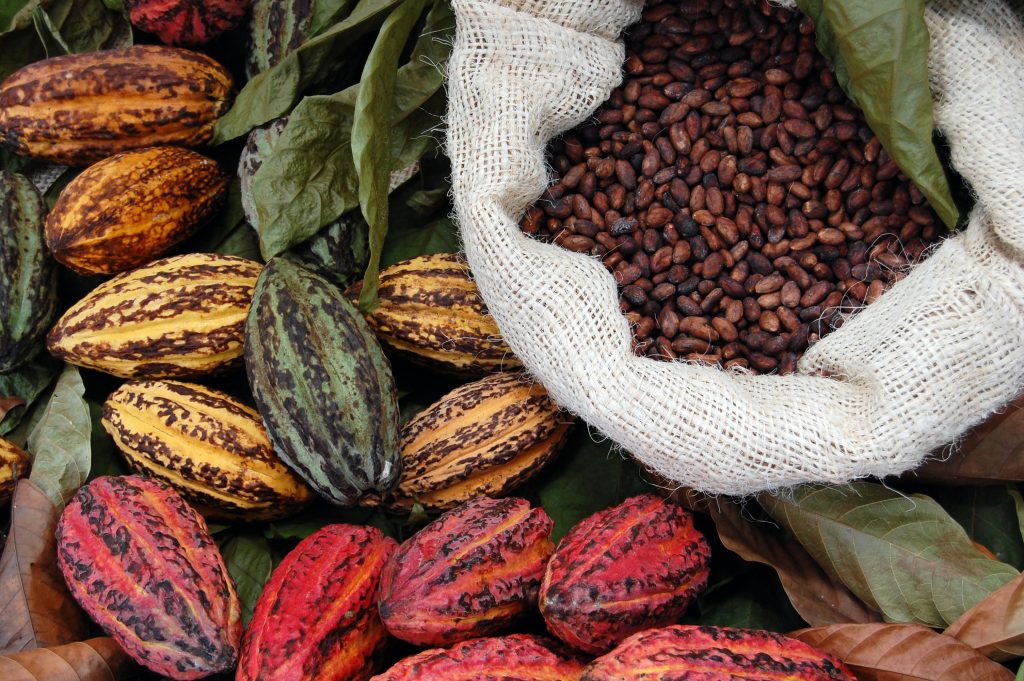- July 2024
Aisha Niazi and Jonas Ngouhouo Poufoun

(Image: Yai, AdobeStock 1160772)
TRADE Hub scientists find cocoa farming in the Tridom landscape within the Congo Basin is associated with higher rates of deforestation than comparable production-based livelihoods.
People in nearby communities tend to be influenced by their neighbours. Families seeing their neighbours make a good income are likely to follow suit to secure their economic livelihoods. In the case of cocoa, scientists find that the higher the income, the higher the risk of deforestation. A balance needs to be struck between ensuring families have access to economic security and preventing long-term damage to forests. This can be achieved by co-designing, with the farmers, sustainable land management practices that contribute to sustainable livelihoods.
Communities in the Tridom landscape rely on both farming and healthy forests
Around 75% of the world’s poor population live in rural areas. Of these, about 90% rely on farming as a source of income. There are many smallholder farmers within the Tridom landscape that spans Cameroon, Congo and Gabon. With high rates of healthy forest coverage, it is home to an abundance of species, including forest elephants. It is also home to small communities, including indigenous peoples, a large amount of whom rely on farming for their livelihoods.
The expansion of cocoa production threatens forest cover
Farmers tend to either specialise in producing one type of commodity or produce a range depending on the season. Ngouhouo-Poufoun and his team found that there is an increasing interest in cocoa, with more people receiving a greater share of their income from its production.
Agricultural expansion driven by local, national and international trade drives about 90% of global deforestation. Cocoa is one of the seven agricultural commodities responsible for 26% of global tree cover loss. An increase in cocoa-based livelihoods without proper land-use planning may, therefore, result in greater deforestation in the Tridom landscape and degrade its forest. This would also harm other communities living in the landscape who depend on forests for food security and spiritual wellbeing.
A balancing act: Supporting both production-based livelihoods and forests
With many communities dependent on both agricultural production-based livelihoods and the forest, solutions must benefit both.
The forest area in the Tridom landscape is split into two types. The first is “permanent forest estate” which cannot be deforested. The second type is “non-permanent forest estate” which can be converted for other uses, notably sustainable agricultural production. However, farms are not always registered, with land being given out informally by local chiefs. This makes it hard to collect data to measure sustainability and conduct proper land-use planning which is essential for sustainable land management.
Furthermore, it is common for forests in non-permanent forest estates to be purposefully burnt without attempts to recover it. When reforestation does occur, often by NGOs or the government, rural households are often left out of the process.
Sustainable and inclusive land management is the way forward
Sustainable practices should include rural households and ensure the long-term health of forests. These practices must also support the economic livelihoods of smallholder farmers. Both can be achieved.
Unsustainable, exploitative farming practices result in lower yields which reduces farmers’ profit margins. More sustainable practices can be implemented with proper land-use planning to contribute to sustainable land management in the long-term. At present, farmers are able to clear non-permanent forest estate at low costs. To enable effective planning, Ngouhouo Poufoun et al recommend a new, binding regime for land acquisition that:
This regime provides incentives for farmers to factor in the long-term health of their land and encourages forward-planning for sustainable practices. For example, land-owners may consider techniques such as fallow which involves leaving the soils to recover by not cropping for a couple of seasons. This improves the forest's health, which provides farmers with greater yields resulting in higher profit margins.
Policies at an international scale are currently focusing on reducing the total biodiversity loss associated with agricultural commodities. For example, the EU Deforestation-free regulation that requires companies to conduct due diligence on purchases to prevent products linked to illegal and legal deforestation from entering EU markets. In this case, more attention needs to be placed on the use of cocoa for sustainable development, building the socioeconomic livelihoods of families and supporting the forest landscape.
The production of cocoa is dependent on healthy, thriving forests. Sustainable land management practices are a vital way to reduce deforestation related to the production of agricultural commodities such as cocoa, as well as support livelihoods.
Read the whole paper to find out more about the deforestation risk related to cocoa in the Tridom landscape and discover how new approaches to sustainable land management can support biodiversity and the livelihoods of farmers.